jacking FORD SIERRA 1992 2.G Braking System Workshop Manual
[x] Cancel search | Manufacturer: FORD, Model Year: 1992, Model line: SIERRA, Model: FORD SIERRA 1992 2.GPages: 22, PDF Size: 1.11 MB
Page 3 of 22
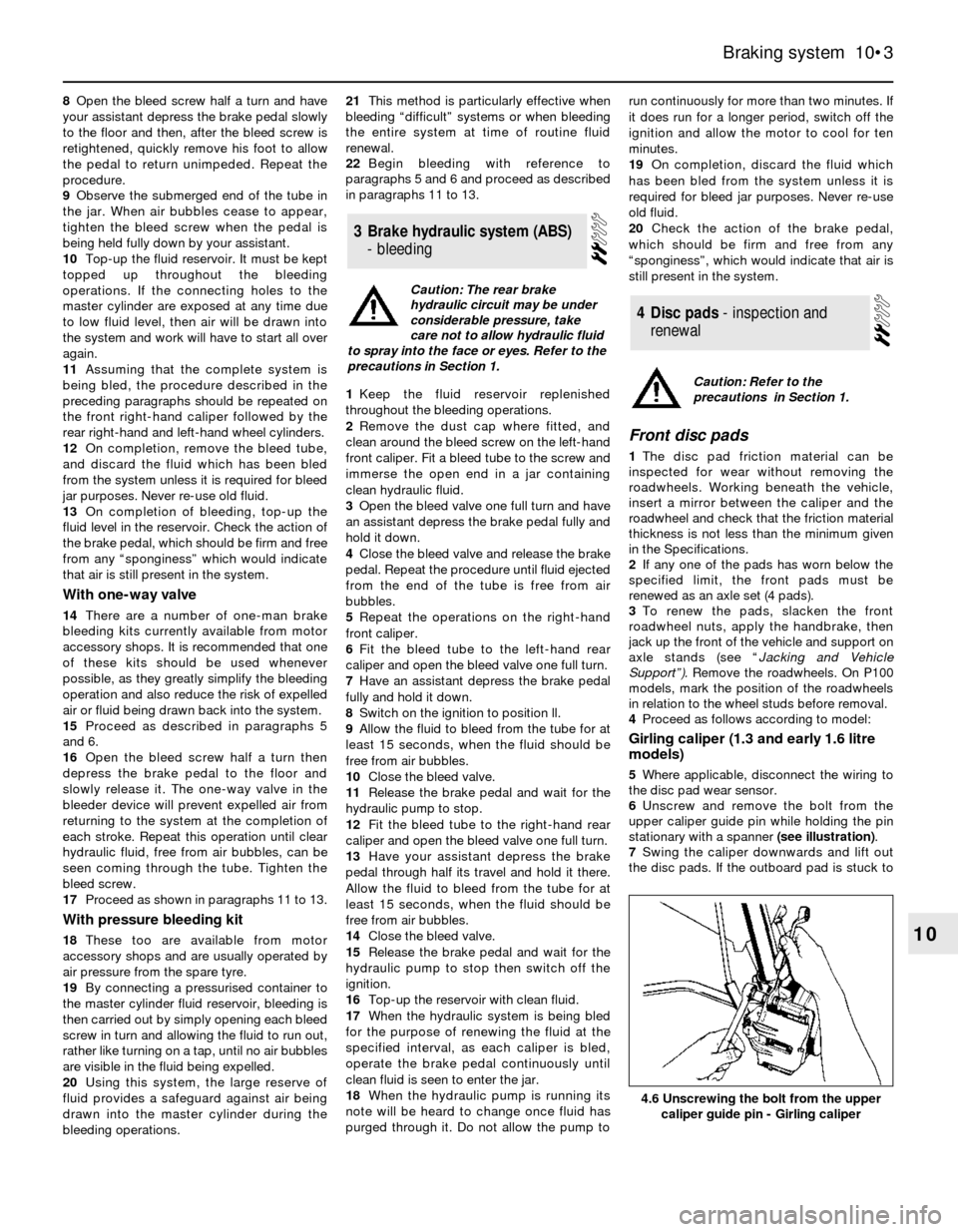
8Open the bleed screw half a turn and have
your assistant depress the brake pedal slowly
to the floor and then, after the bleed screw is
retightened, quickly remove his foot to allow
the pedal to return unimpeded. Repeat the
procedure.
9Observe the submerged end of the tube in
the jar. When air bubbles cease to appear,
tighten the bleed screw when the pedal is
being held fully down by your assistant.
10Top-up the fluid reservoir. It must be kept
topped up throughout the bleeding
operations. If the connecting holes to the
master cylinder are exposed at any time due
to low fluid level, then air will be drawn into
the system and work will have to start all over
again.
11Assuming that the complete system is
being bled, the procedure described in the
preceding paragraphs should be repeated on
the front right-hand caliper followed by the
rear right-hand and left-hand wheel cylinders.
12On completion, remove the bleed tube,
and discard the fluid which has been bled
from the system unless it is required for bleed
jar purposes. Never re-use old fluid.
13On completion of bleeding, top-up the
fluid level in the reservoir. Check the action of
the brake pedal, which should be firm and free
from any “sponginess” which would indicate
that air is still present in the system.
With one-way valve
14There are a number of one-man brake
bleeding kits currently available from motor
accessory shops. It is recommended that one
of these kits should be used whenever
possible, as they greatly simplify the bleeding
operation and also reduce the risk of expelled
air or fluid being drawn back into the system.
15Proceed as described in paragraphs 5
and 6.
16Open the bleed screw half a turn then
depress the brake pedal to the floor and
slowly release it. The one-way valve in the
bleeder device will prevent expelled air from
returning to the system at the completion of
each stroke. Repeat this operation until clear
hydraulic fluid, free from air bubbles, can be
seen coming through the tube. Tighten the
bleed screw.
17Proceed as shown in paragraphs 11 to 13.
With pressure bleeding kit
18These too are available from motor
accessory shops and are usually operated by
air pressure from the spare tyre.
19By connecting a pressurised container to
the master cylinder fluid reservoir, bleeding is
then carried out by simply opening each bleed
screw in turn and allowing the fluid to run out,
rather like turning on a tap, until no air bubbles
are visible in the fluid being expelled.
20Using this system, the large reserve of
fluid provides a safeguard against air being
drawn into the master cylinder during the
bleeding operations.21This method is particularly effective when
bleeding “difficult” systems or when bleeding
the entire system at time of routine fluid
renewal.
22Begin bleeding with reference to
paragraphs 5 and 6 and proceed as described
in paragraphs 11 to 13.
1Keep the fluid reservoir replenished
throughout the bleeding operations.
2Remove the dust cap where fitted, and
clean around the bleed screw on the left-hand
front caliper. Fit a bleed tube to the screw and
immerse the open end in a jar containing
clean hydraulic fluid.
3Open the bleed valve one full turn and have
an assistant depress the brake pedal fully and
hold it down.
4Close the bleed valve and release the brake
pedal. Repeat the procedure until fluid ejected
from the end of the tube is free from air
bubbles.
5Repeat the operations on the right-hand
front caliper.
6Fit the bleed tube to the left-hand rear
caliper and open the bleed valve one full turn.
7Have an assistant depress the brake pedal
fully and hold it down.
8Switch on the ignition to position ll.
9Allow the fluid to bleed from the tube for at
least 15 seconds, when the fluid should be
free from air bubbles.
10Close the bleed valve.
11Release the brake pedal and wait for the
hydraulic pump to stop.
12Fit the bleed tube to the right-hand rear
caliper and open the bleed valve one full turn.
13Have your assistant depress the brake
pedal through half its travel and hold it there.
Allow the fluid to bleed from the tube for at
least 15 seconds, when the fluid should be
free from air bubbles.
14Close the bleed valve.
15Release the brake pedal and wait for the
hydraulic pump to stop then switch off the
ignition.
16Top-up the reservoir with clean fluid.
17When the hydraulic system is being bled
for the purpose of renewing the fluid at the
specified interval, as each caliper is bled,
operate the brake pedal continuously until
clean fluid is seen to enter the jar.
18When the hydraulic pump is running its
note will be heard to change once fluid has
purged through it. Do not allow the pump torun continuously for more than two minutes. If
it does run for a longer period, switch off the
ignition and allow the motor to cool for ten
minutes.
19On completion, discard the fluid which
has been bled from the system unless it is
required for bleed jar purposes. Never re-use
old fluid.
20Check the action of the brake pedal,
which should be firm and free from any
“sponginess”, which would indicate that air is
still present in the system.
Front disc pads
1The disc pad friction material can be
inspected for wear without removing the
roadwheels. Working beneath the vehicle,
insert a mirror between the caliper and the
roadwheel and check that the friction material
thickness is not less than the minimum given
in the Specifications.
2If any one of the pads has worn below the
specified limit, the front pads must be
renewed as an axle set (4 pads).
3To renew the pads, slacken the front
roadwheel nuts, apply the handbrake, then
jack up the front of the vehicle and support on
axle stands (see “Jacking and Vehicle
Support”). Remove the roadwheels. On P100
models, mark the position of the roadwheels
in relation to the wheel studs before removal.
4Proceed as follows according to model:
Girling caliper (1.3 and early 1.6 litre
models)
5Where applicable, disconnect the wiring to
the disc pad wear sensor.
6Unscrew and remove the bolt from the
upper caliper guide pin while holding the pin
stationary with a spanner (see illustration).
7Swing the caliper downwards and lift out
the disc pads. If the outboard pad is stuck to
4Disc pads -inspectionand
renewal
3Brake hydraulic system (ABS)
- bleeding
Braking system 10•3
10
4.6 Unscrewing the bolt from the upper
caliper guide pin - Girling caliper
Caution: Refer to the
precautions in Section 1.
Caution: The rear brake
hydraulic circuit may be under
considerable pressure, take
care not to allow hydraulic fluid
to spray into the face or eyes. Refer to the
precautions in Section 1.
Page 5 of 22
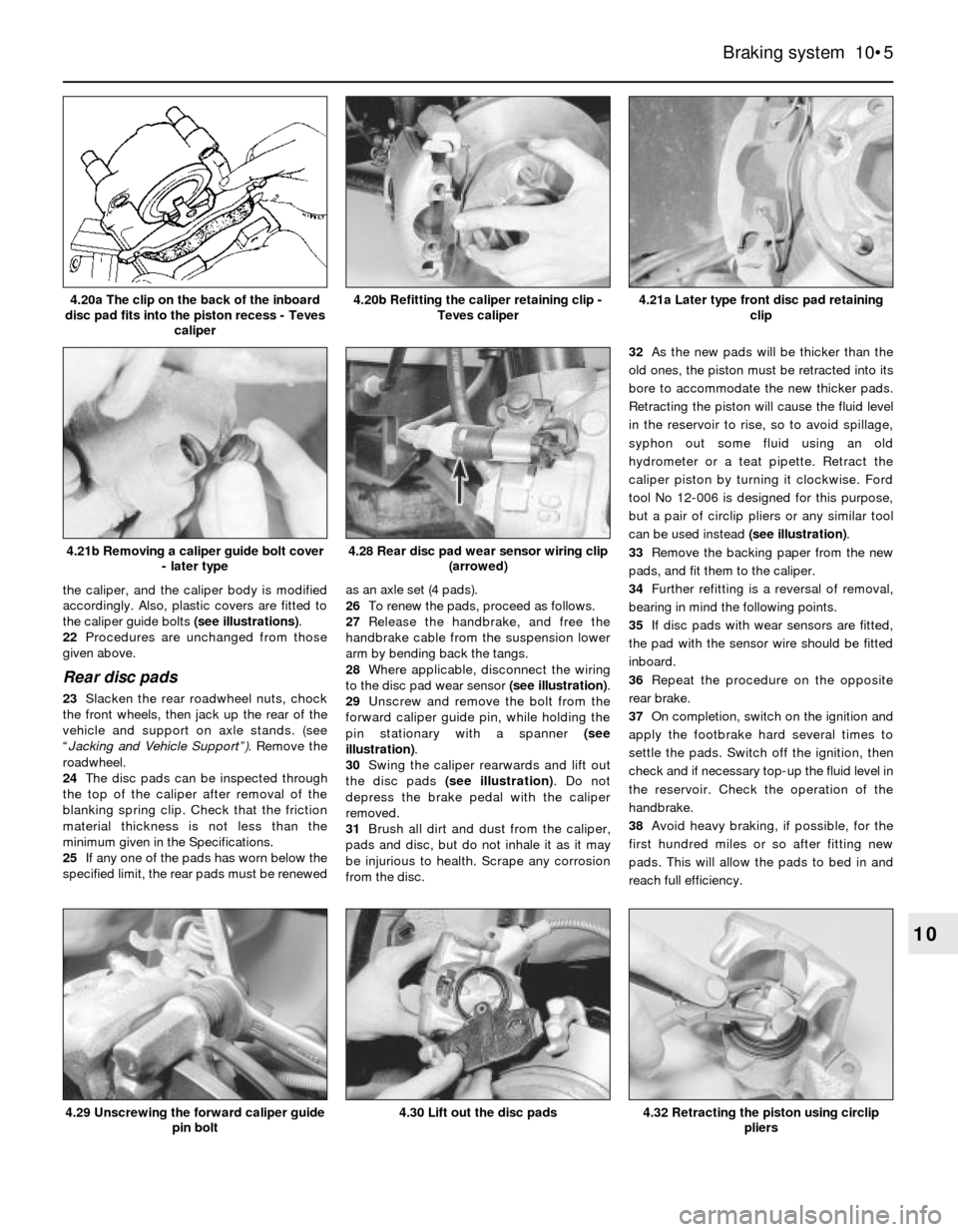
the caliper, and the caliper body is modified
accordingly. Also, plastic covers are fitted to
the caliper guide bolts (see illustrations).
22Procedures are unchanged from those
given above.
Rear disc pads
23Slacken the rear roadwheel nuts, chock
the front wheels, then jack up the rear of the
vehicle and support on axle stands. (see
“Jacking and Vehicle Support”). Remove the
roadwheel.
24The disc pads can be inspected through
the top of the caliper after removal of the
blanking spring clip. Check that the friction
material thickness is not less than the
minimum given in the Specifications.
25If any one of the pads has worn below the
specified limit, the rear pads must be renewedas an axle set (4 pads).
26To renew the pads, proceed as follows.
27Release the handbrake, and free the
handbrake cable from the suspension lower
arm by bending back the tangs.
28Where applicable, disconnect the wiring
to the disc pad wear sensor (see illustration).
29Unscrew and remove the bolt from the
forward caliper guide pin, while holding the
pin stationary with a spanner (see
illustration).
30Swing the caliper rearwards and lift out
the disc pads (see illustration). Do not
depress the brake pedal with the caliper
removed.
31Brush all dirt and dust from the caliper,
pads and disc, but do not inhale it as it may
be injurious to health. Scrape any corrosion
from the disc.32As the new pads will be thicker than the
old ones, the piston must be retracted into its
bore to accommodate the new thicker pads.
Retracting the piston will cause the fluid level
in the reservoir to rise, so to avoid spillage,
syphon out some fluid using an old
hydrometer or a teat pipette. Retract the
caliper piston by turning it clockwise. Ford
tool No 12-006 is designed for this purpose,
but a pair of circlip pliers or any similar tool
can be used instead (see illustration).
33Remove the backing paper from the new
pads, and fit them to the caliper.
34Further refitting is a reversal of removal,
bearing in mind the following points.
35If disc pads with wear sensors are fitted,
the pad with the sensor wire should be fitted
inboard.
36Repeat the procedure on the opposite
rear brake.
37On completion, switch on the ignition and
apply the footbrake hard several times to
settle the pads. Switch off the ignition, then
check and if necessary top-up the fluid level in
the reservoir. Check the operation of the
handbrake.
38Avoid heavy braking, if possible, for the
first hundred miles or so after fitting new
pads. This will allow the pads to bed in and
reach full efficiency.
Braking system 10•5
10
4.21a Later type front disc pad retaining
clip
4.32 Retracting the piston using circlip
pliers4.30 Lift out the disc pads
4.28 Rear disc pad wear sensor wiring clip
(arrowed)
4.29 Unscrewing the forward caliper guide
pin bolt
4.21b Removing a caliper guide bolt cover
- later type
4.20b Refitting the caliper retaining clip -
Teves caliper4.20a The clip on the back of the inboard
disc pad fits into the piston recess - Teves
caliper
Page 6 of 22
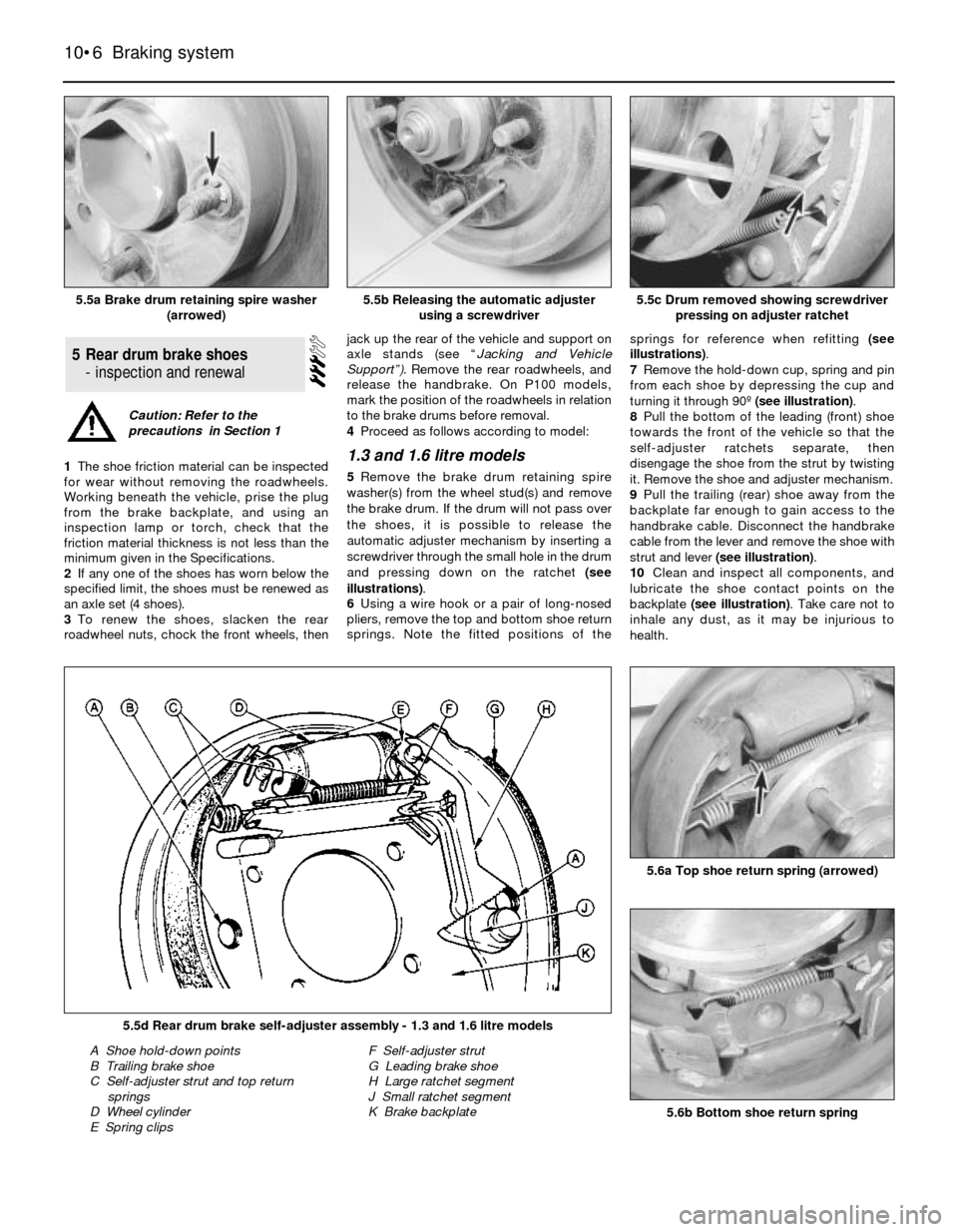
1The shoe friction material can be inspected
for wear without removing the roadwheels.
Working beneath the vehicle, prise the plug
from the brake backplate, and using an
inspection lamp or torch, check that the
friction material thickness is not less than the
minimum given in the Specifications.
2If any one of the shoes has worn below the
specified limit, the shoes must be renewed as
an axle set (4 shoes).
3To renew the shoes, slacken the rear
roadwheel nuts, chock the front wheels, thenjack up the rear of the vehicle and support on
axle stands (see “Jacking and Vehicle
Support”).Remove the rear roadwheels, and
release the handbrake. On P100 models,
mark the position of the roadwheels in relation
to the brake drums before removal.
4Proceed as follows according to model:1.3 and 1.6 litre models
5Remove the brake drum retaining spire
washer(s) from the wheel stud(s) and remove
the brake drum. If the drum will not pass over
the shoes, it is possible to release the
automatic adjuster mechanism by inserting a
screwdriver through the small hole in the drum
and pressing down on the ratchet (see
illustrations).
6Using a wire hook or a pair of long-nosed
pliers, remove the top and bottom shoe return
springs. Note the fitted positions of thesprings for reference when refitting (see
illustrations).
7Remove the hold-down cup, spring and pin
from each shoe by depressing the cup and
turning it through 90º (see illustration).
8Pull the bottom of the leading (front) shoe
towards the front of the vehicle so that the
self-adjuster ratchets separate, then
disengage the shoe from the strut by twisting
it. Remove the shoe and adjuster mechanism.
9Pull the trailing (rear) shoe away from the
backplate far enough to gain access to the
handbrake cable. Disconnect the handbrake
cable from the lever and remove the shoe with
strut and lever (see illustration).
10Clean and inspect all components, and
lubricate the shoe contact points on the
backplate (see illustration). Take care not to
inhale any dust, as it may be injurious to
health.
5Rear drum brake shoes
- inspection and renewal
10•6Braking system
5.5a Brake drum retaining spire washer
(arrowed)5.5c Drum removed showing screwdriver
pressing on adjuster ratchet
5.6b Bottom shoe return spring
5.6a Top shoe return spring (arrowed)
5.5d Rear drum brake self-adjuster assembly - 1.3 and 1.6 litre models
A Shoe hold-down points
B Trailing brake shoe
C Self-adjuster strut and top return
springs
D Wheel cylinder
E Spring clipsF Self-adjuster strut
G Leading brake shoe
H Large ratchet segment
J Small ratchet segment
K Brake backplate
5.5b Releasing the automatic adjuster
using a screwdriver
Caution: Refer to the
precautions in Section 1
Page 8 of 22
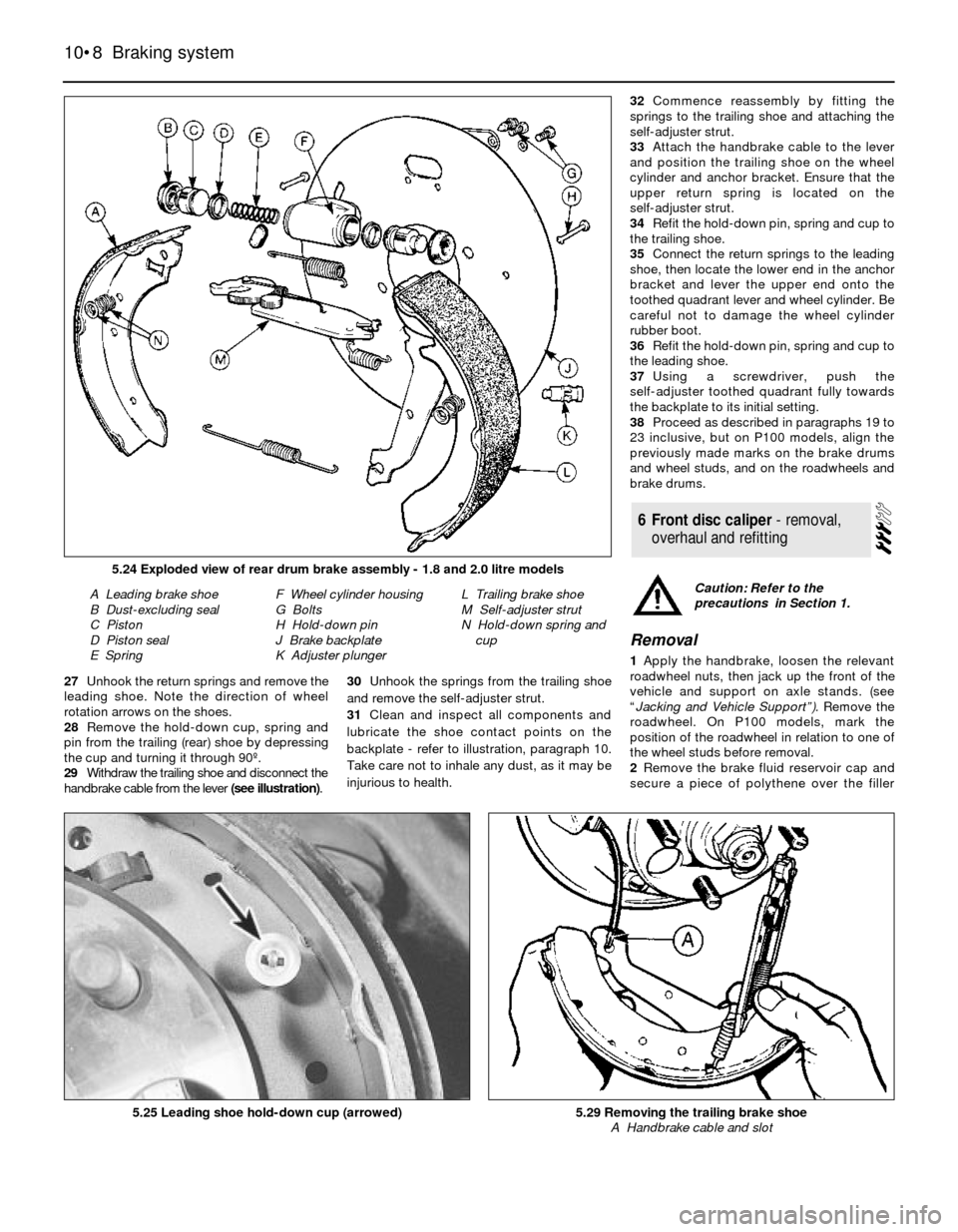
27Unhook the return springs and remove the
leading shoe. Note the direction of wheel
rotation arrows on the shoes.
28Remove the hold-down cup, spring and
pin from the trailing (rear) shoe by depressing
the cup and turning it through 90º.
29Withdraw the trailing shoe and disconnect the
handbrake cable from the lever (see illustration).30Unhook the springs from the trailing shoe
and remove the self-adjuster strut.
31Clean and inspect all components and
lubricate the shoe contact points on the
backplate - refer to illustration, paragraph 10.
Take care not to inhale any dust, as it may be
injurious to health.32Commence reassembly by fitting the
springs to the trailing shoe and attaching the
self-adjuster strut.
33Attach the handbrake cable to the lever
and position the trailing shoe on the wheel
cylinder and anchor bracket. Ensure that the
upper return spring is located on the
self-adjuster strut.
34Refit the hold-down pin, spring and cup to
the trailing shoe.
35Connect the return springs to the leading
shoe, then locate the lower end in the anchor
bracket and lever the upper end onto the
toothed quadrant lever and wheel cylinder. Be
careful not to damage the wheel cylinder
rubber boot.
36Refit the hold-down pin, spring and cup to
the leading shoe.
37Using a screwdriver, push the
self-adjuster toothed quadrant fully towards
the backplate to its initial setting.
38Proceed as described in paragraphs 19 to
23 inclusive, but on P100 models, align the
previously made marks on the brake drums
and wheel studs, and on the roadwheels and
brake drums.
Removal
1Apply the handbrake, loosen the relevant
roadwheel nuts, then jack up the front of the
vehicle and support on axle stands. (see
“Jacking and Vehicle Support”). Remove the
roadwheel. On P100 models, mark the
position of the roadwheel in relation to one of
the wheel studs before removal.
2Remove the brake fluid reservoir cap and
secure a piece of polythene over the filler
6Front disc caliper - removal,
overhaul and refitting
10•8Braking system
5.24 Exploded view of rear drum brake assembly - 1.8 and 2.0 litre models
A Leading brake shoe
B Dust-excluding seal
C Piston
D Piston seal
E SpringF Wheel cylinder housing
G Bolts
H Hold-down pin
J Brake backplate
K Adjuster plungerL Trailing brake shoe
M Self-adjuster strut
N Hold-down spring and
cup
5.25 Leading shoe hold-down cup (arrowed)5.29 Removing the trailing brake shoe
A Handbrake cable and slot
Caution: Refer to the
precautions in Section 1.
Page 10 of 22
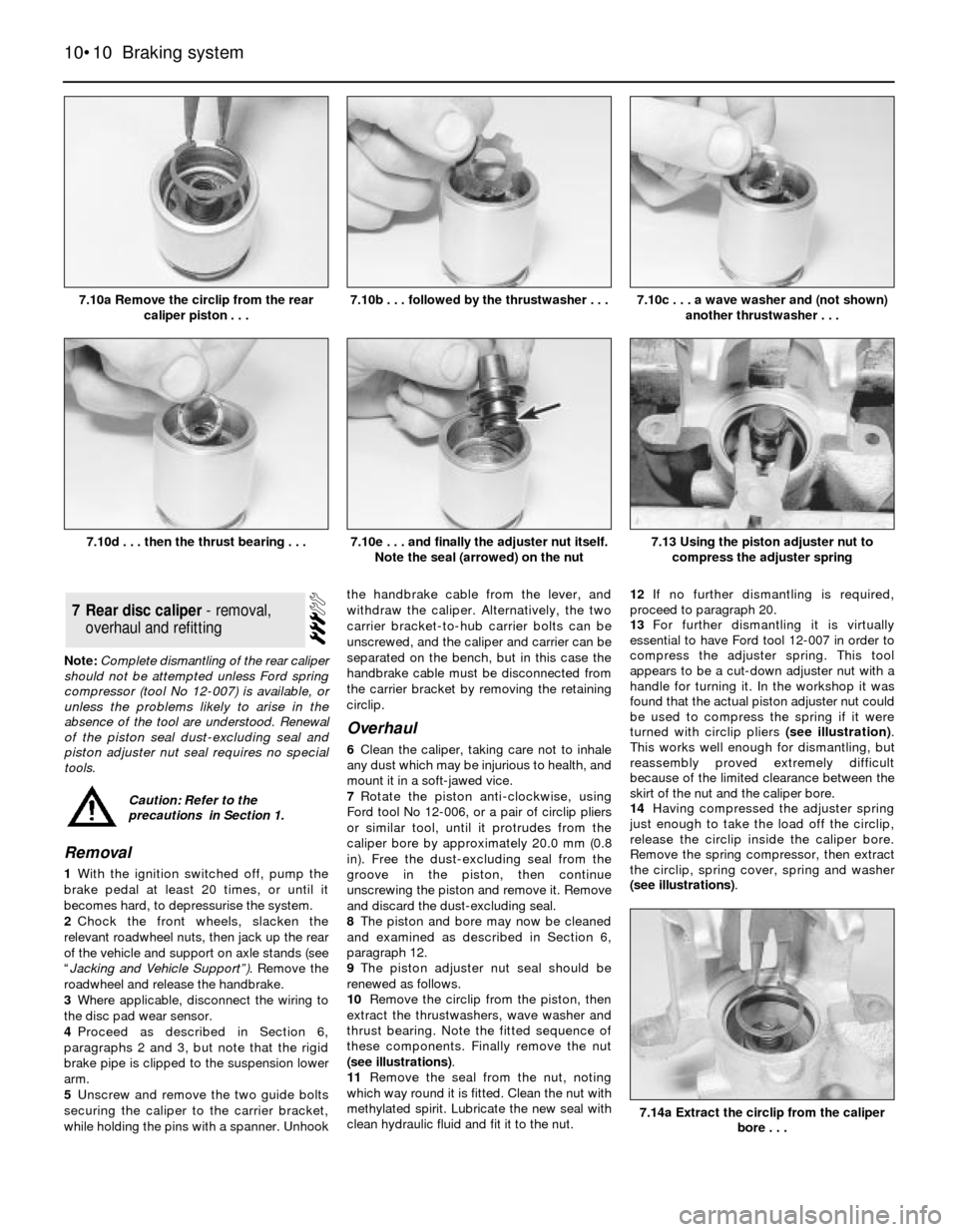
Note: Complete dismantling of the rear caliper
should not be attempted unless Ford spring
compressor (tool No 12-007) is available, or
unless the problems likely to arise in the
absence of the tool are understood. Renewal
of the piston seal dust-excluding seal and
piston adjuster nut seal requires no special
tools.
Removal
1With the ignition switched off, pump the
brake pedal at least 20 times, or until it
becomes hard, to depressurise the system.
2Chock the front wheels, slacken the
relevant roadwheel nuts, then jack up the rear
of the vehicle and support on axle stands (see
“Jacking and Vehicle Support”). Remove the
roadwheel and release the handbrake.
3Where applicable, disconnect the wiring to
the disc pad wear sensor.
4Proceed as described in Section 6,
paragraphs 2 and 3, but note that the rigid
brake pipe is clipped to the suspension lower
arm.
5Unscrew and remove the two guide bolts
securing the caliper to the carrier bracket,
while holding the pins with a spanner. Unhookthe handbrake cable from the lever, and
withdraw the caliper. Alternatively, the two
carrier bracket-to-hub carrier bolts can be
unscrewed, and the caliper and carrier can be
separated on the bench, but in this case the
handbrake cable must be disconnected from
the carrier bracket by removing the retaining
circlip.
Overhaul
6Clean the caliper, taking care not to inhale
any dust which may be injurious to health, and
mount it in a soft-jawed vice.
7Rotate the piston anti-clockwise, using
Ford tool No 12-006, or a pair of circlip pliers
or similar tool, until it protrudes from the
caliper bore by approximately 20.0 mm (0.8
in). Free the dust-excluding seal from the
groove in the piston, then continue
unscrewing the piston and remove it. Remove
and discard the dust-excluding seal.
8The piston and bore may now be cleaned
and examined as described in Section 6,
paragraph 12.
9The piston adjuster nut seal should be
renewed as follows.
10Remove the circlip from the piston, then
extract the thrustwashers, wave washer and
thrust bearing. Note the fitted sequence of
these components. Finally remove the nut
(see illustrations).
11Remove the seal from the nut, noting
which way round it is fitted. Clean the nut with
methylated spirit. Lubricate the new seal with
clean hydraulic fluid and fit it to the nut.12If no further dismantling is required,
proceed to paragraph 20.
13For further dismantling it is virtually
essential to have Ford tool 12-007 in order to
compress the adjuster spring. This tool
appears to be a cut-down adjuster nut with a
handle for turning it. In the workshop it was
found that the actual piston adjuster nut could
be used to compress the spring if it were
turned with circlip pliers (see illustration).
This works well enough for dismantling, but
reassembly proved extremely difficult
because of the limited clearance between the
skirt of the nut and the caliper bore.
14Having compressed the adjuster spring
just enough to take the load off the circlip,
release the circlip inside the caliper bore.
Remove the spring compressor, then extract
the circlip, spring cover, spring and washer
(see illustrations).
7Rear disc caliper - removal,
overhaul and refitting
10•10Braking system
7.10a Remove the circlip from the rear
caliper piston . . .7.10c . . . a wave washer and (not shown)
another thrustwasher . . .
7.14a Extract the circlip from the caliper
bore . . .
7.13 Using the piston adjuster nut to
compress the adjuster spring7.10e . . . and finally the adjuster nut itself.
Note the seal (arrowed) on the nut7.10d . . . then the thrust bearing . . .
7.10b . . . followed by the thrustwasher . . .
Caution: Refer to the
precautions in Section 1.
Page 11 of 22
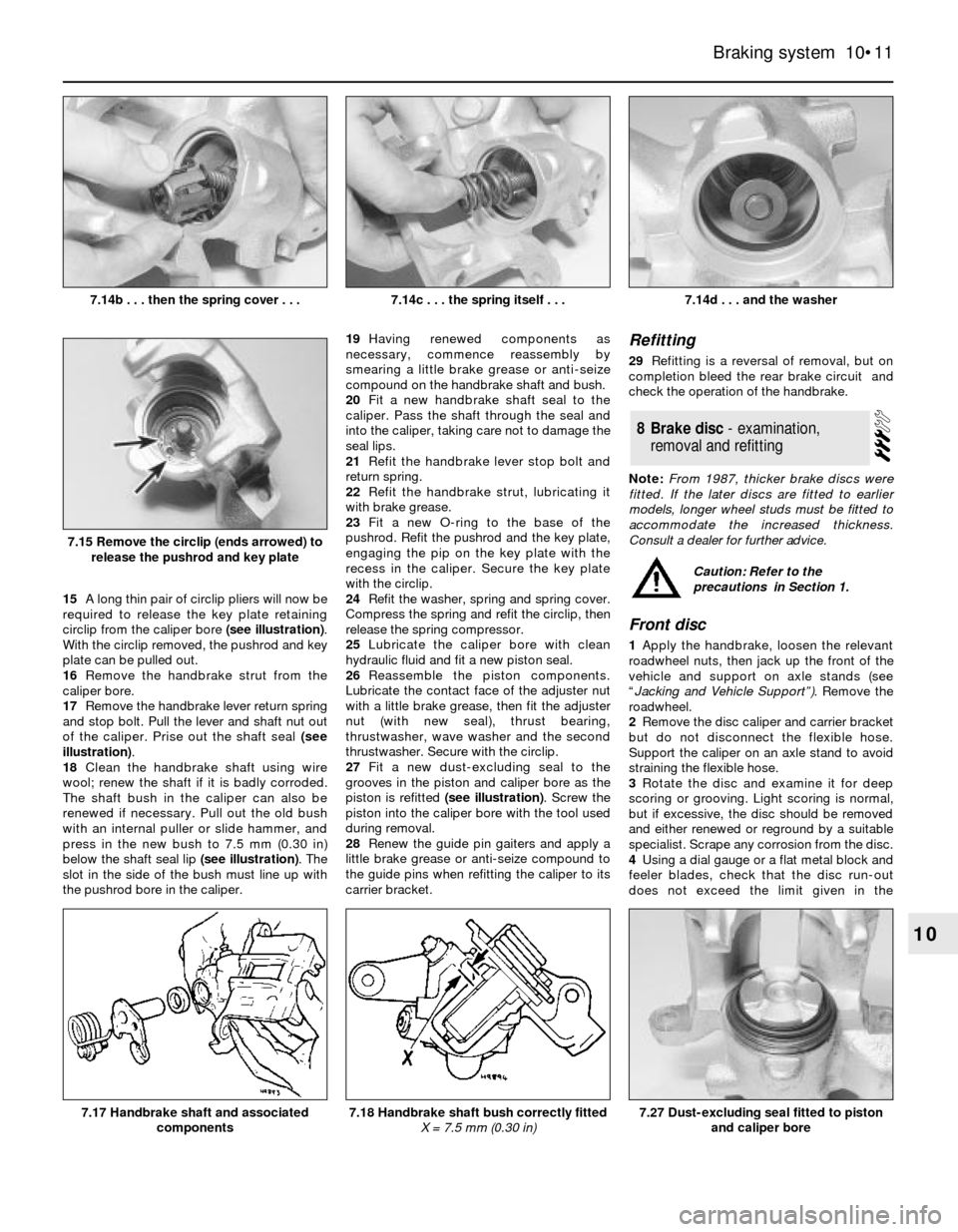
15A long thin pair of circlip pliers will now be
required to release the key plate retaining
circlip from the caliper bore (see illustration).
With the circlip removed, the pushrod and key
plate can be pulled out.
16Remove the handbrake strut from the
caliper bore.
17Remove the handbrake lever return spring
and stop bolt. Pull the lever and shaft nut out
of the caliper. Prise out the shaft seal (see
illustration).
18Clean the handbrake shaft using wire
wool; renew the shaft if it is badly corroded.
The shaft bush in the caliper can also be
renewed if necessary. Pull out the old bush
with an internal puller or slide hammer, and
press in the new bush to 7.5 mm (0.30 in)
below the shaft seal lip (see illustration). The
slot in the side of the bush must line up with
the pushrod bore in the caliper.19Having renewed components as
necessary, commence reassembly by
smearing a little brake grease or anti-seize
compound on the handbrake shaft and bush.
20Fit a new handbrake shaft seal to the
caliper. Pass the shaft through the seal and
into the caliper, taking care not to damage the
seal lips.
21Refit the handbrake lever stop bolt and
return spring.
22Refit the handbrake strut, lubricating it
with brake grease.
23Fit a new O-ring to the base of the
pushrod. Refit the pushrod and the key plate,
engaging the pip on the key plate with the
recess in the caliper. Secure the key plate
with the circlip.
24Refit the washer, spring and spring cover.
Compress the spring and refit the circlip, then
release the spring compressor.
25Lubricate the caliper bore with clean
hydraulic fluid and fit a new piston seal.
26Reassemble the piston components.
Lubricate the contact face of the adjuster nut
with a little brake grease, then fit the adjuster
nut (with new seal), thrust bearing,
thrustwasher, wave washer and the second
thrustwasher. Secure with the circlip.
27Fit a new dust-excluding seal to the
grooves in the piston and caliper bore as the
piston is refitted (see illustration). Screw the
piston into the caliper bore with the tool used
during removal.
28Renew the guide pin gaiters and apply a
little brake grease or anti-seize compound to
the guide pins when refitting the caliper to its
carrier bracket.
Refitting
29Refitting is a reversal of removal, but on
completion bleed the rear brake circuit and
check the operation of the handbrake.
Note: From 1987, thicker brake discs were
fitted. If the later discs are fitted to earlier
models, longer wheel studs must be fitted to
accommodate the increased thickness.
Consult a dealer for further advice.
Front disc
1Apply the handbrake, loosen the relevant
roadwheel nuts, then jack up the front of the
vehicle and support on axle stands (see
“Jacking and Vehicle Support”). Remove the
roadwheel.
2Remove the disc caliper and carrier bracket
but do not disconnect the flexible hose.
Support the caliper on an axle stand to avoid
straining the flexible hose.
3Rotate the disc and examine it for deep
scoring or grooving. Light scoring is normal,
but if excessive, the disc should be removed
and either renewed or reground by a suitable
specialist. Scrape any corrosion from the disc.
4Using a dial gauge or a flat metal block and
feeler blades, check that the disc run-out
does not exceed the limit given in the
8Brake disc - examination,
removal and refitting
Braking system 10•11
10
7.14d . . . and the washer
7.27 Dust-excluding seal fitted to piston
and caliper bore7.18 Handbrake shaft bush correctly fitted
X = 7.5 mm (0.30 in)7.17 Handbrake shaft and associated
components
7.15 Remove the circlip (ends arrowed) to
release the pushrod and key plate
7.14c . . . the spring itself . . .7.14b . . . then the spring cover . . .
Caution: Refer to the
precautions in Section 1.
Page 12 of 22
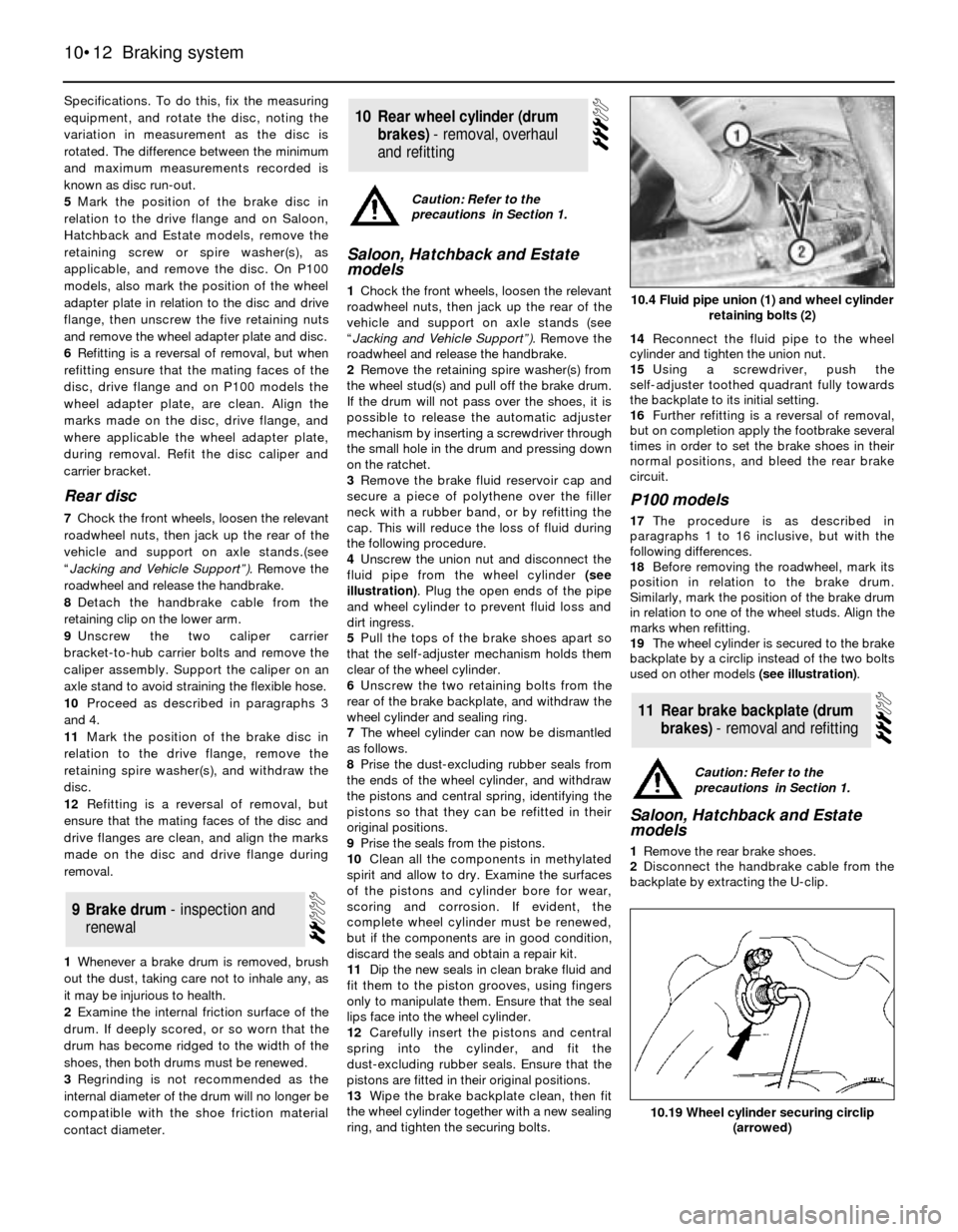
Specifications. To do this, fix the measuring
equipment, and rotate the disc, noting the
variation in measurement as the disc is
rotated. The difference between the minimum
and maximum measurements recorded is
known as disc run-out.
5Mark the position of the brake disc in
relation to the drive flange and on Saloon,
Hatchback and Estate models, remove the
retaining screw or spire washer(s), as
applicable, and remove the disc. On P100
models, also mark the position of the wheel
adapter plate in relation to the disc and drive
flange, then unscrew the five retaining nuts
and remove the wheel adapter plate and disc.
6Refitting is a reversal of removal, but when
refitting ensure that the mating faces of the
disc, drive flange and on P100 models the
wheel adapter plate, are clean. Align the
marks made on the disc, drive flange, and
where applicable the wheel adapter plate,
during removal. Refit the disc caliper and
carrier bracket.
Rear disc
7Chock the front wheels, loosen the relevant
roadwheel nuts, then jack up the rear of the
vehicle and support on axle stands.(see
“Jacking and Vehicle Support”).Remove the
roadwheel and release the handbrake.
8Detach the handbrake cable from the
retaining clip on the lower arm.
9Unscrew the two caliper carrier
bracket-to-hub carrier bolts and remove the
caliper assembly. Support the caliper on an
axle stand to avoid straining the flexible hose.
10Proceed as described in paragraphs 3
and 4.
11Mark the position of the brake disc in
relation to the drive flange, remove the
retaining spire washer(s), and withdraw the
disc.
12Refitting is a reversal of removal, but
ensure that the mating faces of the disc and
drive flanges are clean, and align the marks
made on the disc and drive flange during
removal.
1Whenever a brake drum is removed, brush
out the dust, taking care not to inhale any, as
it may be injurious to health.
2Examine the internal friction surface of the
drum. If deeply scored, or so worn that the
drum has become ridged to the width of the
shoes, then both drums must be renewed.
3Regrinding is not recommended as the
internal diameter of the drum will no longer be
compatible with the shoe friction material
contact diameter.
Saloon, Hatchback and Estate
models
1Chock the front wheels, loosen the relevant
roadwheel nuts, then jack up the rear of the
vehicle and support on axle stands (see
“Jacking and Vehicle Support”).Remove the
roadwheel and release the handbrake.
2Remove the retaining spire washer(s) from
the wheel stud(s) and pull off the brake drum.
If the drum will not pass over the shoes, it is
possible to release the automatic adjuster
mechanism by inserting a screwdriver through
the small hole in the drum and pressing down
on the ratchet.
3Remove the brake fluid reservoir cap and
secure a piece of polythene over the filler
neck with a rubber band, or by refitting the
cap. This will reduce the loss of fluid during
the following procedure.
4Unscrew the union nut and disconnect the
fluid pipe from the wheel cylinder (see
illustration). Plug the open ends of the pipe
and wheel cylinder to prevent fluid loss and
dirt ingress.
5Pull the tops of the brake shoes apart so
that the self-adjuster mechanism holds them
clear of the wheel cylinder.
6Unscrew the two retaining bolts from the
rear of the brake backplate, and withdraw the
wheel cylinder and sealing ring.
7The wheel cylinder can now be dismantled
as follows.
8Prise the dust-excluding rubber seals from
the ends of the wheel cylinder, and withdraw
the pistons and central spring, identifying the
pistons so that they can be refitted in their
original positions.
9Prise the seals from the pistons.
10Clean all the components in methylated
spirit and allow to dry. Examine the surfaces
of the pistons and cylinder bore for wear,
scoring and corrosion. If evident, the
complete wheel cylinder must be renewed,
but if the components are in good condition,
discard the seals and obtain a repair kit.
11Dip the new seals in clean brake fluid and
fit them to the piston grooves, using fingers
only to manipulate them. Ensure that the seal
lips face into the wheel cylinder.
12Carefully insert the pistons and central
spring into the cylinder, and fit the
dust-excluding rubber seals. Ensure that the
pistons are fitted in their original positions.
13Wipe the brake backplate clean, then fit
the wheel cylinder together with a new sealing
ring, and tighten the securing bolts.14Reconnect the fluid pipe to the wheel
cylinder and tighten the union nut.
15Using a screwdriver, push the
self-adjuster toothed quadrant fully towards
the backplate to its initial setting.
16Further refitting is a reversal of removal,
but on completion apply the footbrake several
times in order to set the brake shoes in their
normal positions, and bleed the rear brake
circuit.
P100 models
17The procedure is as described in
paragraphs 1 to 16 inclusive, but with the
following differences.
18Before removing the roadwheel, mark its
position in relation to the brake drum.
Similarly, mark the position of the brake drum
in relation to one of the wheel studs. Align the
marks when refitting.
19The wheel cylinder is secured to the brake
backplate by a circlip instead of the two bolts
used on other models (see illustration).
Saloon, Hatchback and Estate
models
1Remove the rear brake shoes.
2Disconnect the handbrake cable from the
backplate by extracting the U-clip.
11Rear brake backplate (drum
brakes) - removal and refitting
10Rear wheel cylinder (drum
brakes) -removal,overhaul
andrefitting
9Brake drum -inspectionand
renewal
10•12Braking system
10.4 Fluid pipe union (1) and wheel cylinder
retaining bolts (2)
10.19 Wheel cylinder securing circlip
(arrowed)
Caution: Refer to the
precautions in Section 1.
Caution: Refer to the
precautions in Section 1.
Page 13 of 22
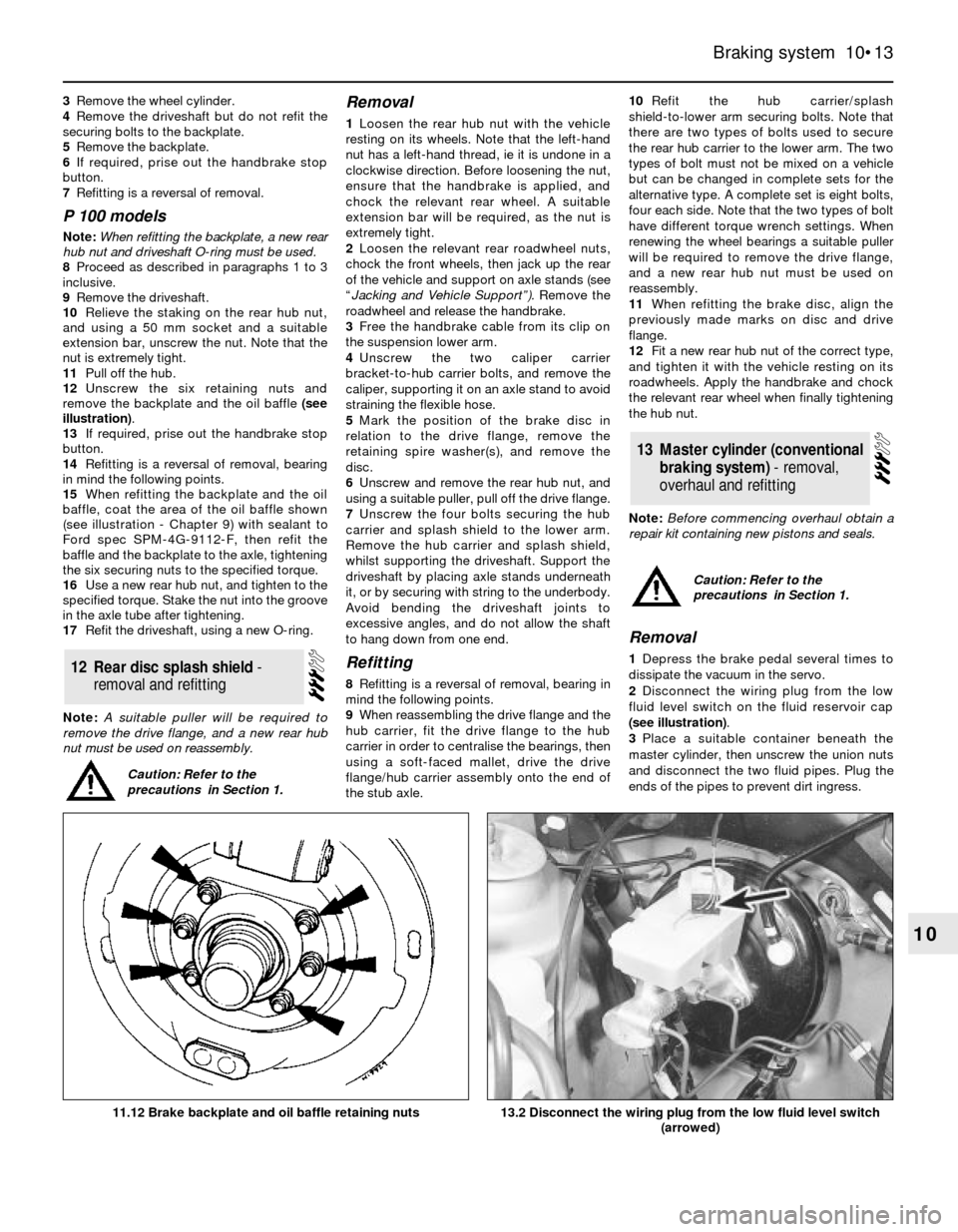
3Remove the wheel cylinder.
4Remove the driveshaft but do not refit the
securing bolts to the backplate.
5Remove the backplate.
6If required, prise out the handbrake stop
button.
7Refitting is a reversal of removal.
P 100 models
Note: When refitting the backplate, a new rear
hub nut and driveshaft O-ring must be used.
8Proceed as described in paragraphs 1 to 3
inclusive.
9Remove the driveshaft.
10Relieve the staking on the rear hub nut,
and using a 50 mm socket and a suitable
extension bar, unscrew the nut. Note that the
nut is extremely tight.
11Pull off the hub.
12Unscrew the six retaining nuts and
remove the backplate and the oil baffle (see
illustration).
13If required, prise out the handbrake stop
button.
14Refitting is a reversal of removal, bearing
in mind the following points.
15When refitting the backplate and the oil
baffle, coat the area of the oil baffle shown
(see illustration - Chapter 9) with sealant to
Ford spec SPM-4G-9112-F, then refit the
baffle and the backplate to the axle, tightening
the six securing nuts to the specified torque.
16Use a new rear hub nut, and tighten to the
specified torque. Stake the nut into the groove
in the axle tube after tightening.
17Refit the driveshaft, using a new O-ring.
Note: A suitable puller will be required to
remove the drive flange, and a new rear hub
nut must be used on reassembly.
Removal
1Loosen the rear hub nut with the vehicle
resting on its wheels. Note that the left-hand
nut has a left-hand thread, ie it is undone in a
clockwise direction. Before loosening the nut,
ensure that the handbrake is applied, and
chock the relevant rear wheel. A suitable
extension bar will be required, as the nut is
extremely tight.
2Loosen the relevant rear roadwheel nuts,
chock the front wheels, then jack up the rear
of the vehicle and support on axle stands (see
“Jacking and Vehicle Support”).Remove the
roadwheel and release the handbrake.
3Free the handbrake cable from its clip on
the suspension lower arm.
4Unscrew the two caliper carrier
bracket-to-hub carrier bolts, and remove the
caliper, supporting it on an axle stand to avoid
straining the flexible hose.
5Mark the position of the brake disc in
relation to the drive flange, remove the
retaining spire washer(s), and remove the
disc.
6Unscrew and remove the rear hub nut, and
using a suitable puller, pull off the drive flange.
7Unscrew the four bolts securing the hub
carrier and splash shield to the lower arm.
Remove the hub carrier and splash shield,
whilst supporting the driveshaft. Support the
driveshaft by placing axle stands underneath
it, or by securing with string to the underbody.
Avoid bending the driveshaft joints to
excessive angles, and do not allow the shaft
to hang down from one end.
Refitting
8Refitting is a reversal of removal, bearing in
mind the following points.
9When reassembling the drive flange and the
hub carrier, fit the drive flange to the hub
carrier in order to centralise the bearings, then
using a soft-faced mallet, drive the drive
flange/hub carrier assembly onto the end of
the stub axle.10Refit the hub carrier/splash
shield-to-lower arm securing bolts. Note that
there are two types of bolts used to secure
the rear hub carrier to the lower arm. The two
types of bolt must not be mixed on a vehicle
but can be changed in complete sets for the
alternative type. A complete set is eight bolts,
four each side. Note that the two types of bolt
have different torque wrench settings. When
renewing the wheel bearings a suitable puller
will be required to remove the drive flange,
and a new rear hub nut must be used on
reassembly.
11When refitting the brake disc, align the
previously made marks on disc and drive
flange.
12Fit a new rear hub nut of the correct type,
and tighten it with the vehicle resting on its
roadwheels. Apply the handbrake and chock
the relevant rear wheel when finally tightening
the hub nut.
Note: Before commencing overhaul obtain a
repair kit containing new pistons and seals.
Removal
1Depress the brake pedal several times to
dissipate the vacuum in the servo.
2Disconnect the wiring plug from the low
fluid level switch on the fluid reservoir cap
(see illustration).
3Place a suitable container beneath the
master cylinder, then unscrew the union nuts
and disconnect the two fluid pipes. Plug the
ends of the pipes to prevent dirt ingress.
13Master cylinder (conventional
braking system) - removal,
overhaul and refitting
12Rear disc splash shield -
removal and refitting
Braking system 10•13
10
13.2 Disconnect the wiring plug from the low fluid level switch
(arrowed)11.12 Brake backplate and oil baffle retaining nuts
Caution: Refer to the
precautions in Section 1.
Caution: Refer to the
precautions in Section 1.
Page 17 of 22
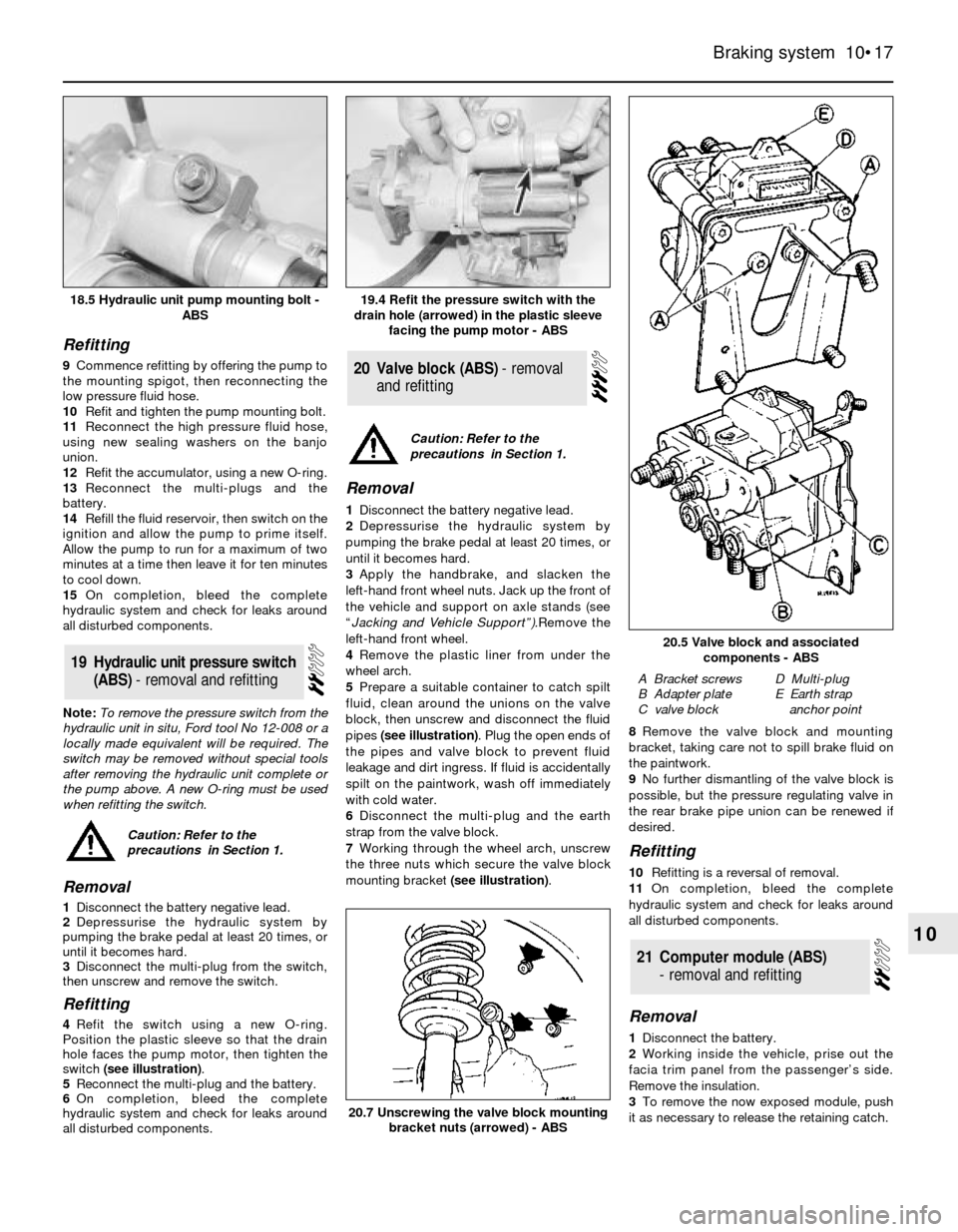
Refitting
9Commence refitting by offering the pump to
the mounting spigot, then reconnecting the
low pressure fluid hose.
10Refit and tighten the pump mounting bolt.
11Reconnect the high pressure fluid hose,
using new sealing washers on the banjo
union.
12Refit the accumulator, using a new O-ring.
13Reconnect the multi-plugs and the
battery.
14Refill the fluid reservoir, then switch on the
ignition and allow the pump to prime itself.
Allow the pump to run for a maximum of two
minutes at a time then leave it for ten minutes
to cool down.
15On completion, bleed the complete
hydraulic system and check for leaks around
all disturbed components.
Note: To remove the pressure switch from the
hydraulic unit in situ, Ford tool No 12-008 or a
locally made equivalent will be required. The
switch may be removed without special tools
after removing the hydraulic unit complete or
the pump above. A new O-ring must be used
when refitting the switch.
Removal
1Disconnect the battery negative lead.
2Depressurise the hydraulic system by
pumping the brake pedal at least 20 times, or
until it becomes hard.
3Disconnect the multi-plug from the switch,
then unscrew and remove the switch.
Refitting
4Refit the switch using a new O-ring.
Position the plastic sleeve so that the drain
hole faces the pump motor, then tighten the
switch (see illustration).
5Reconnect the multi-plug and the battery.
6On completion, bleed the complete
hydraulic system and check for leaks around
all disturbed components.
Removal
1Disconnect the battery negative lead.
2Depressurise the hydraulic system by
pumping the brake pedal at least 20 times, or
until it becomes hard.
3Apply the handbrake, and slacken the
left-hand front wheel nuts. Jack up the front of
the vehicle and support on axle stands (see
“Jacking and Vehicle Support”).Remove the
left-hand front wheel.
4Remove the plastic liner from under the
wheel arch.
5Prepare a suitable container to catch spilt
fluid, clean around the unions on the valve
block, then unscrew and disconnect the fluid
pipes (see illustration). Plug the open ends of
the pipes and valve block to prevent fluid
leakage and dirt ingress. If fluid is accidentally
spilt on the paintwork, wash off immediately
with cold water.
6Disconnect the multi-plug and the earth
strap from the valve block.
7Working through the wheel arch, unscrew
the three nuts which secure the valve block
mounting bracket (see illustration).8Remove the valve block and mounting
bracket, taking care not to spill brake fluid on
the paintwork.
9No further dismantling of the valve block is
possible, but the pressure regulating valve in
the rear brake pipe union can be renewed if
desired.
Refitting
10Refitting is a reversal of removal.
11On completion, bleed the complete
hydraulic system and check for leaks around
all disturbed components.
Removal
1Disconnect the battery.
2Working inside the vehicle, prise out the
facia trim panel from the passenger’s side.
Remove the insulation.
3To remove the now exposed module, push
it as necessary to release the retaining catch.
21Computer module (ABS)
- removal and refitting
20Valve block (ABS) -removal
andrefitting
19Hydraulic unit pressure switch
(ABS) - removal and refitting
Braking system 10•17
10
20.5 Valve block and associated
components - ABS
A Bracket screws
B Adapter plate
C valve blockD Multi-plug
E Earth strap
anchor point
19.4 Refit the pressure switch with the
drain hole (arrowed) in the plastic sleeve
facing the pump motor - ABS18.5 Hydraulic unit pump mounting bolt -
ABS
20.7 Unscrewing the valve block mounting
bracket nuts (arrowed) - ABS
Caution: Refer to the
precautions in Section 1.
Caution: Refer to the
precautions in Section 1.
Page 18 of 22
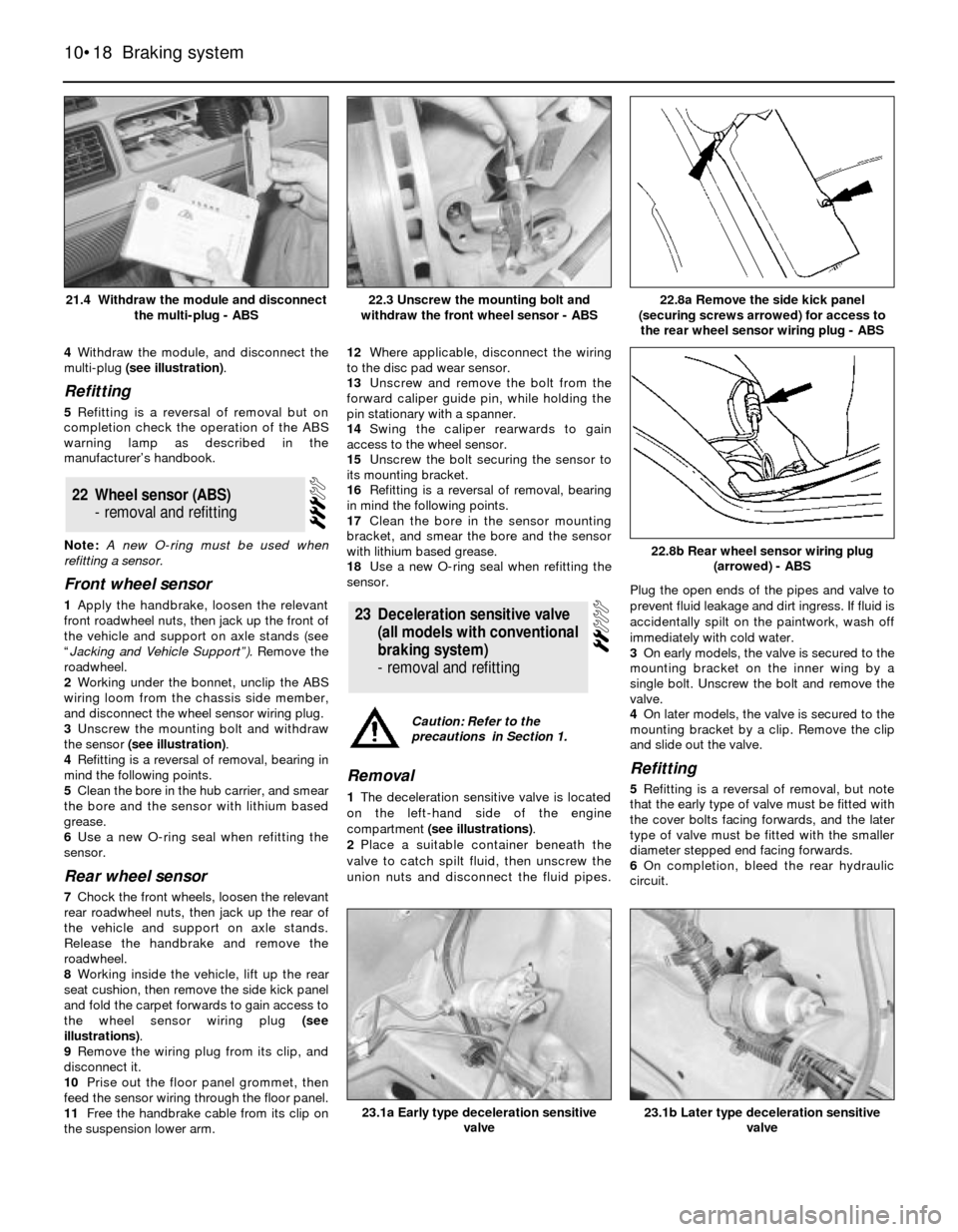
4Withdraw the module, and disconnect the
multi-plug (see illustration).
Refitting
5Refitting is a reversal of removal but on
completion check the operation of the ABS
warning lamp as described in the
manufacturer’s handbook.
Note: A new O-ring must be used when
refitting a sensor.
Front wheel sensor
1Apply the handbrake, loosen the relevant
front roadwheel nuts, then jack up the front of
the vehicle and support on axle stands (see
“Jacking and Vehicle Support”). Remove the
roadwheel.
2Working under the bonnet, unclip the ABS
wiring loom from the chassis side member,
and disconnect the wheel sensor wiring plug.
3Unscrew the mounting bolt and withdraw
the sensor (see illustration).
4Refitting is a reversal of removal, bearing in
mind the following points.
5Clean the bore in the hub carrier, and smear
the bore and the sensor with lithium based
grease.
6Use a new O-ring seal when refitting the
sensor.
Rear wheel sensor
7Chock the front wheels, loosen the relevant
rear roadwheel nuts, then jack up the rear of
the vehicle and support on axle stands.
Release the handbrake and remove the
roadwheel.
8Working inside the vehicle, lift up the rear
seat cushion, then remove the side kick panel
and fold the carpet forwards to gain access to
the wheel sensor wiring plug (see
illustrations).
9Remove the wiring plug from its clip, and
disconnect it.
10Prise out the floor panel grommet, then
feed the sensor wiring through the floor panel.
11Free the handbrake cable from its clip on
the suspension lower arm.12Where applicable, disconnect the wiring
to the disc pad wear sensor.
13Unscrew and remove the bolt from the
forward caliper guide pin, while holding the
pin stationary with a spanner.
14Swing the caliper rearwards to gain
access to the wheel sensor.
15Unscrew the bolt securing the sensor to
its mounting bracket.
16Refitting is a reversal of removal, bearing
in mind the following points.
17Clean the bore in the sensor mounting
bracket, and smear the bore and the sensor
with lithium based grease.
18Use a new O-ring seal when refitting the
sensor.
Removal
1The deceleration sensitive valve is located
on the left-hand side of the engine
compartment (see illustrations).
2Place a suitable container beneath the
valve to catch spilt fluid, then unscrew the
union nuts and disconnect the fluid pipes.Plug the open ends of the pipes and valve to
prevent fluid leakage and dirt ingress. If fluid is
accidentally spilt on the paintwork, wash off
immediately with cold water.
3On early models, the valve is secured to the
mounting bracket on the inner wing by a
single bolt. Unscrew the bolt and remove the
valve.
4On later models, the valve is secured to the
mounting bracket by a clip. Remove the clip
and slide out the valve.
Refitting
5Refitting is a reversal of removal, but note
that the early type of valve must be fitted with
the cover bolts facing forwards, and the later
type of valve must be fitted with the smaller
diameter stepped end facing forwards.
6On completion, bleed the rear hydraulic
circuit.
23Deceleration sensitive valve
(all models with conventional
braking system)
- removal and refitting
22Wheel sensor (ABS)
- removal and refitting
10•18Braking system
21.4 Withdraw the module and disconnect
the multi-plug - ABS22.8a Remove the side kick panel
(securing screws arrowed) for access to
the rear wheel sensor wiring plug - ABS
23.1b Later type deceleration sensitive
valve23.1a Early type deceleration sensitive
valve
22.8b Rear wheel sensor wiring plug
(arrowed) - ABS
22.3 Unscrew the mounting bolt and
withdraw the front wheel sensor - ABS
Caution: Refer to the
precautions in Section 1.